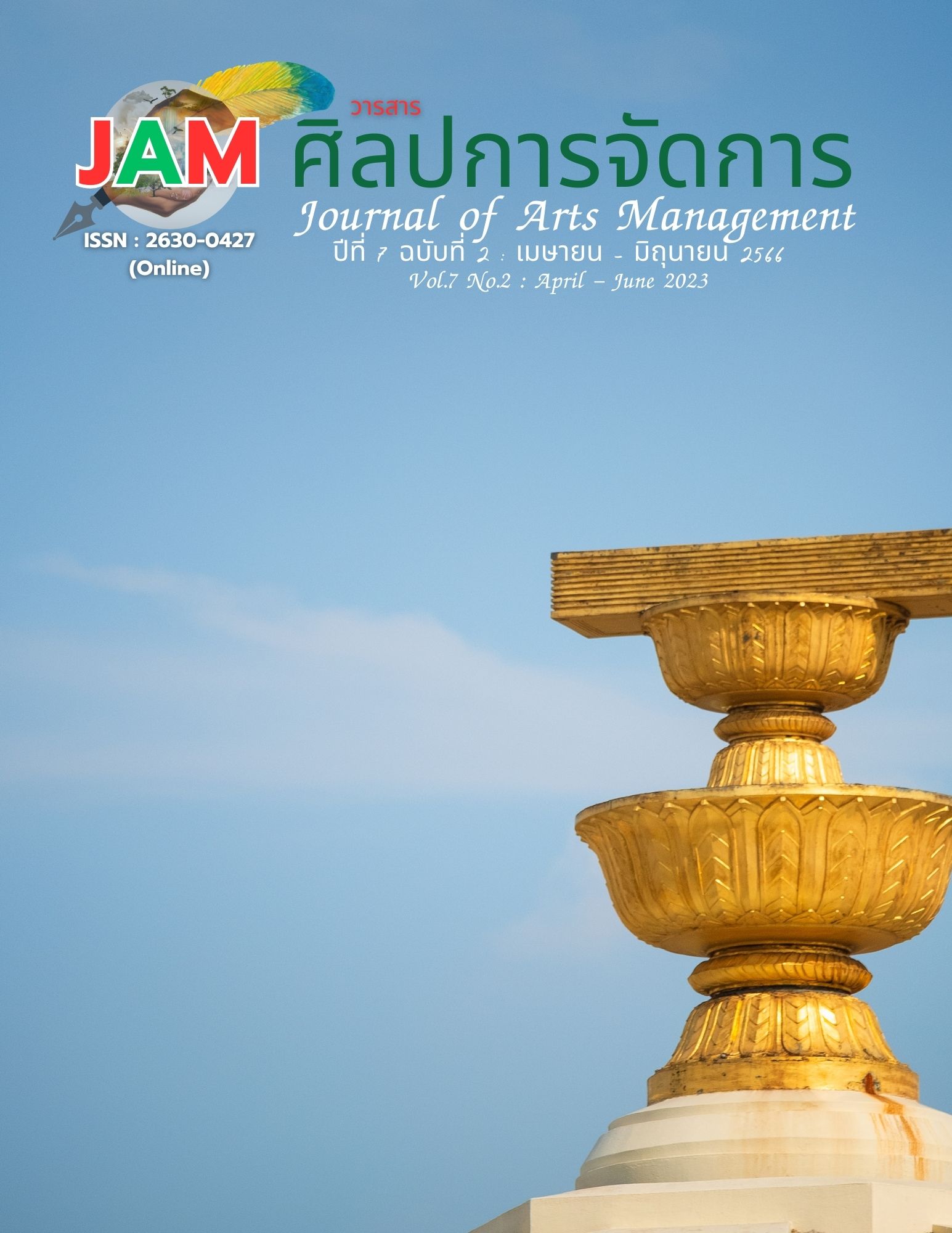A Study of Factors Influencing Happiness at Work for Supervisors: Hitachi Industrial Technology (Thailand) Co., Ltd.
Main Article Content
Abstract
This research aimed to study factors influencing happiness at work for supervisors of Hitachi Industrial Technology (Thailand) Co., Ltd. through random sampling from 169 supervisor-level employees of Hitachi Industrial Technology (Thailand). The questionnaire was used as a data collection technique, using SEM, or structural equation modeling, to examine the data. The results showed that the level of happiness at work among the respondents was high, and structural validity was consistent with the empirical data. The concordance index was chi-squared at 13.21, df = 5, p-value = 0.86, TLI = 1.12, GFI = 0.96, CFI = 1.06, SRMR = 0.03, and RMSEA = 0.02. The factors that directly and positively influenced each other were of statistical significance at 0.05: 1) relationships at work; 2) recognition; 3) career advancement; 4) work environment; and 5) job characteristics, respectively.
Article Details

This work is licensed under a Creative Commons Attribution-NonCommercial-NoDerivatives 4.0 International License.
Views and opinions appearing in articles in the Journal of Arts of Management It is the responsibility of the author of the article. and does not constitute the view and responsibility of the editorial team I agree that the article is copyright of the Arts and Management Journal.
References
Al Maktoum, M. B. R. (2017). Reflections on Happiness & Positivity. Explorer Publishing & Distribution.
Anderson, J. C., & Gerbing, D. W. (1988). Structural Equation Modeling in Practice: A Review and Recommended Two-step Approach. Psychological Bulletin, 103(3), 411–423. ttps://doi.org/10.1037/0033-2909.103.3.411
Bader, H.A.M., Hashim, I.H.M., & Zaharim, N.M. (2013), Workplace Friendships among Bank Employees in Eastern Libya. Domes: Digest of Middle East Studies, 22(1), 94-116. https://doi.org/10.1111/dome.12020
Boonthawee, P. (2018). Factors Affecting Happiness in Working. The Work of the Officers of the Revenue Office in Bangkok Area 7, the Revenue Department[Unpublished Master’s Thesis, Mahidol University].
Byrne, B. M. (2010). Structural Equation Modeling with AMOS Basic Concepts, Applications, and Programming (2nd ed.). Routledge.
Chuenboon, A., Loluwiwat, R., Mungsongnern, S., Pochakaparipan, J., & Chongchanil, S. (2013). Factors Affecting the Happy Workplace of Personal in Saint Mary Hospital. Panyapiwat, 4(special), 73-85.
Diener, E., Suh, E. M., Lucas, R. E., & Smith, H. L. (1999). Subjective Well-being: Three Decades of Progress. Psychological Bulletin, 125(2), 276–302. https://doi.org/10.1037/0033-2909.125.2.276
Guna, N. (2019). Happiness at Work of Workers in Sub-district Administrative Offices in Muang Pattani District, Pattani Province[Unpublished Master’s Thesis, Prince of Songkhla University].
Haar, J., Schmitz, A., Di Fabio, A., & Daellenbach, U. (2019). The Role of Relationships at Work and Happiness: A Moderated Mediation Study of New Zealand Managers. Sustainability, 11(12), 3443. http://dx.doi.org/10.3390/su11123443
Hansomsakul, R. (2007). The Relationship Between Personal Factors, A Suitable Working Environment, and Happiness in Work Performance of Nursing Personnel Stationed in Hospitals under the Department of Corrections[Unpublished Master’s Thesis, Chulalongkorn University].
Hu, L.T, & Bentler, P.M. (1999). Cutoff Criteria for Fit Indexes in Covariance Structure Analysis: Conventional Criteria Versus New Alternatives. Structural Equation Modeling, 6(1), 1–55. https://doi.org/10.1080/10705519909540118
Kahneman, D., & Krueger, A.B. (2006). Developments in the Measurement of Subjective Well-Being. Journal of Economic Perspectives, 20, 3-24. http://dx.doi.org/10.1257/089533006776526030
Kline, R. B. (2010). Principles and Practice of Structural Equation Modeling (3rd ed.). Guilford Press.
Maenapothi, R. (2007). Happiness in the Workplace Indicator[Unpublished Master’s Thesis, National Institute of Development Administration].
Malairungskul, B. (2009). Environmental Factors and Happiness at Work of Registered Nurses in Public University Hospitals[Unpublished Master’s Thesis, Chiang Mai University].
Manion J. (2003). Joy at Work!: Creating a Positive Workplace. The Journal of Nursing Administration, 33(12), 652–659. https://doi.org/10.1097/00005110-200312000-00008
Ongkana, K. (2006). The Relationship Between Personal Factors, Self-worth Work Environment and Happiness in Doing the Work of a Regular Nurse Private Hospital Bangkok[Unpublished Master’s Thesis, Chulalongkorn University].
Oswald, A.J., Proto, E., & Sgroi, D. (2015) Happiness and Productivity. Journal of Labor Economics, 33(4), 789-822.
Phasukyeud, P. (2006, November 9). Happy Workplace-Heaven at work. Gotoknow. https://gotoknow.org/blog/beyondkm/58183
Phromsri, C. (2010, August 19). Happiness at Work. Knowledge Center. https://www.bu.ac.th /knowledgecenter/executive_journal/jan_mar_10/pdf/89-91.pdf
Rodtiang, N. (2007). Factors Influencing Happiness at Work of Personnel under the Health Center in the Northeastern Region, Department of Health, Ministry of Public Health[Unpublished Master’s Thesis, Mahidol University].
Saechua, S. (2010). Happiness at Work of Creative Personnel: A Case Study of Creative Industry, Media Group and Functional Creative Group[Unpublished Master’s Thesis, National Institute of Development Administration].
Schumacker, R. E., & Lomax, R. G. (2016). A Beginner's Guide to Structural Equation Modeling (4th Ed.). Routledge.
Soper, D. (2004). Free Statistics Calculators. Danielsoper. https://www.danielsoper.com/statcalc /default.aspx
Suebsuk, P. (2005). Relationships Between Work Characteristics, Transformational Leadership of Head Nurses and Joy at Work of Staff Nurses, Governmental University Hospitals[Unpublished Master’s Thesis, Chulalongkorn University].
Tangmalai, P. (2010). Happiness at Work of Central Maintenance Division Employees Mae Moh Power Plant, Lampang Province[Unpublished Master’s Thesis, Chiang Mai University].
Tangpoo, S., & Sutthasart, A. (2018). Work Happiness of the Public Company Personnel. Rommayasan, 16(1), 63-84.
University of Oxford. (2019, October 24). Happy Workers are 13% More Productive. University of Oxford. https://www.ox.ac.uk/news/2019-10-24-happy-workers-are-13-more-productive
Waichareon, N. (2010). Factors Affecting Happiness at Work of Production Operators in Companies. UTAC Thai Co., Ltd. (Head Office)[Unpublished Master’s Thesis, Kasetsart University].
Wolf, E. J., Harrington, K. M., Clark, S. L., & Miller, M. W. (2013). Sample Size Requirements for Structural Equation Models. Educational and Psychological Measurement, 73(6), 913–934.


